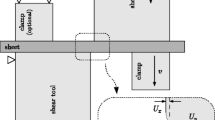Abstract
Failure during sheared edge stretching of sheet steels is a serious concern, especially in advanced high-strength steel (AHSS) grades. The shearing process produces a shear face and a zone of deformation behind the shear face, which is the shear-affected zone (SAZ). A failure during sheared edge stretching depends on prior deformation in the sheet, the shearing process, and the subsequent strain path in the SAZ during stretching. Data from laboratory hole expansion tests and hole extrusion tests for multiple lots of fourteen grades of steel were analyzed. The forming limit curve (FLC), regression equations, measurement uncertainty calculations, and difference calculations were used in the analyses. From these analyses, an assessment of the primary factors that contribute to the fracture during sheared edge stretching was made. It was found that the forming limit strain with consideration of strain path in the SAZ is a major factor that contributes to the failure of a sheared edge during stretching. Although metallurgical factors are important, they appear to play a somewhat lesser role.



Similar content being viewed by others
References
R.D. Adamczyk, D.W. Dickinson, and R.P. Krupitzer, The Edge Formability of High-Strength Cold Rolled Steel, High Strength Steel for Automotive Use, Society of Automotive Engineers, Warrendale, PA, USA, 1983, p 55–67
R.D. Adamczyk, G.M. Michal, “Sheared Edge Extension of High Strength Cold Rolled Sheets”, Journal of Applied Metalworking, Vol. 4, 1986, p 157–163
R.J. Comstock, D.K. Scherre, R.D. Adamczyk, “Hole Expansion in a Variety of Sheet Steels”, Journal of Materials Engineering and Performance, Vol. 15, 2006, p 675–683
R.G. Davies, “Edge Cracking in High Strength Steels”, Journal of Applied Metalworking, Vol. 2, 1983, p 293–299
Z. Milosevic and R. Moussy, Simulation of Sheared Edge Behaviour in Stretch Flanging by a Modified Fukui Test, Advanced Technology of Plasticity, Vol. II, 1987, p 697–702
Y. Seo, “Improving Blank Conditions in Progressive Stamping: Reducing Edge Defects Improves Subsequent Forming”, Stamping Journal, Vol. 15, 2003, p 38–40
R.R. Pradhan, S.C. Kelley, and R.E. Fraley, Some Performance Aspects of Dual-Phase Steels in Comparison to HSLA, C-Mn and TRIP Steels, SAE Paper Number 2004-01-0505, SAE 2004 World Congress, 2004
A.A. Konieczny, On Formabiltiy Limitations in Stamping Involving Sheared Edge Stretching, SAE Paper Number 2007-01-0340, SAE 2007 World Congress, 2007
N. Lazaridus, Private Communication, November, 1986
S.P. Keeler, Understanding Sheet Metal Formability, Part 5-Die Design and Lubrication, Machinery, Vol. 74, no. 10, June, 1968
S.P. Keeler and W.G. Brazier, Relationship Between Laboratory Material Characterization and Press Shop Formability, Proceedings of the Conference on Microalloying ‘75, 1977, p 517–528
R. Soldaat, Private Communication, Unpublished Work of the NADDRG on the Keeler-Brazier Equation, circa early 1990s, December, 2000
S.P. Keeler, Private Communications on Proper n Value for Use in the Keeler-Brazier Equation, 1990-2000
S. Sriram, C. Wong, M. Huang, B. Yan, and D. Urban, Formability Characterization of a New Generation of High Strength Steels, Report No. 0012, American Iron and Steel Institute Technology Roadmap Program Office, Pittsburgh, PA, USA, 2003
B.S. Levy and D.E. Green, The Enhanced FLC Effect, Auto Steel Partnership Report, http://www.a-sp.org/database/pdf/Research%20Report.pdf, 2002
Acknowledgments
The authors thank the Auto/Steel Partnership in Southfield, MI, USA for partial support of this work. The authors also thank personnel at Ispat-Inland (now Arcelor Mittal) Research Laboratory in East Chicago, IL, USA for their work on the American Iron and Steel Institute project (Ref 14).
Author information
Authors and Affiliations
Corresponding author
Rights and permissions
About this article
Cite this article
Levy, B., Van Tyne, C. Failure During Sheared Edge Stretching. J. of Materi Eng and Perform 17, 842–848 (2008). https://doi.org/10.1007/s11665-008-9218-4
Received:
Accepted:
Published:
Issue Date:
DOI: https://doi.org/10.1007/s11665-008-9218-4




